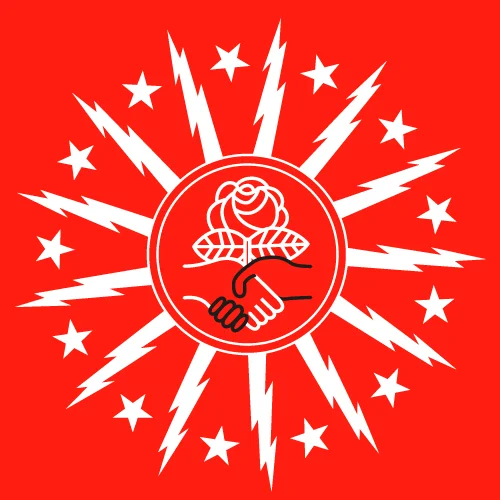

Buffalo DSA Statement on The Blizzard of ‘22
We, the Steering Committee of the Buffalo Democratic Socialists of America, reflect on the aftermath of the Blizzard of ‘22, as we mourn the lives of at least 40 of our fellow citizens with many more wounded. Some, including children, are left permanently crippled from frostbite induced amputations.
A devastating blizzard brought our region to a standstill, forcing us to barricade ourselves in our homes for the entirety of the Christmas weekend. If we were lucky, we were trapped with food, electricity, heat, and our loved ones. The less fortunate among us endured blackouts, freezing indoor temperatures, and depleted supplies – some alone, many without help. For days we looked out our windows, shocked that we could not see our neighbor’s house forty feet away. During the storm we were told search and rescue efforts had been suspended; those of us in danger were on our own.
As we consider the complete collapse of municipal society, there is surely blame to go around. However, we are not naive to think that some other leader could have magically done much more to ameliorate the worst effects of the blizzard, given the priorities of this city over the years and the infrastructure and municipal services produced by those priorities.
For decades, we’ve prioritized car infrastructure over all other modes of transportation. Many Buffalonians will tell you that the reason everyone needs to drive and own a car is because of the snow, but the truth is, every personal automobile is a massive liability during extreme snowfall. Dozens died in their cars when they got stuck, more when they ventured out on foot without functioning public transit or reliable warming centers. Thousands of vehicles, including three quarters of all emergency vehicles deployed during the storm, were abandoned. This blocked roads and further complicated search and rescue operations. Even in the storm’s aftermath, a pedestrian was hit and seriously injured by a motorist on Dec. 30 while walking in the street, as many sidewalks were still completely impassable because the city and county only care about snow removal for cars.
For public safety and first responders, we’ve prioritized the militarization of police over disaster preparedness. Police had to ask people with snow mobiles to help, since we’ve let them spend their money on SWAT trucks and riot gear instead of track vehicles and emergency response equipment. We spend 20% of our city’s annual budget on police, but a small fraction of that on the Department of Public Works; as a result, the city of Buffalo was last in the county in lifting our travel ban, forcing those of us living paycheck to paycheck to potentially go another day without work and those of us low on supplies to go another day without.
This disaster further laid bare the unequal investment in Buffalo. Maps showing power outages are the same as every other map of Buffalo – a city divided by decades of racial and class segregation, resulting in huge swaths of our city facing poorly maintained infrastructure. Power lines are buried in the rich parts of town, but in poor neighborhoods, we still rely on century-old overhead wires that left thousands in the dark. Slumlords let apartments rot, while elected officials and city hall turn a blind eye and accept their campaign donations.
As a result, many of our homes lacked sufficient insulation and heating capacity to keep us warm throughout the days-long blizzard. In areas where the city has failed to invest in our pipes, people lost water. And while neighborhoods with surviving local businesses that have owners and workers living within walking distance could keep their residents supplied, areas with only discount national chains found themselves without, and saw widespread looting.
These challenges are complex, connected, and vast, but they are not insurmountable. They require not just a change in leadership (although one is long overdue), but a fundamental change in our priorities.
Take, for instance, reliable public transportation. Had we spent the last 60 years expanding our subway network instead of building and maintaining highways which stayed closed throughout the storm, we’d have a reliable way for people to travel to safety, and lifesaving refuge from the elements spread throughout the city. We’re spending $100 million to bring cars back to Main St. downtown, meaning our lone light rail line can be rendered useless by a single stranded motorist. Plus, our city doesn’t have a written plan for keeping sidewalks clear, much less dedicated transit infrastructure that can’t be blocked by abandoned cars. This hardly seems like preparedness for “normal snowfall,” as City Hall claims it’s prepared for.
If we had public safety that was accountable to the needs and demands of our citizens, then maybe the police would be prepared better for severe weather than they are for protests against their own brutality. Maybe we wouldn’t have to hear cries for help go unanswered on police scanners, then hear those calls go hauntingly quiet as the night wore on.
If we recognized each other’s shared humanity and prioritized all our citizens regardless of their ability to buy into our most exclusive and expensive neighborhoods, then perhaps the poorest among us wouldn’t suffer the most when disaster strikes, and all of us would be able to lead safe, dignified lives.
Make no mistake, we have not seen the last of storms like the one we just witnessed. Lake Erie still hasn’t frozen over, leading to over 100” of snowfall, and we’ve hardly entered January. This is the second deadly storm that has brought our city to halt in the past six weeks. We cannot afford to wait preparing for the next one.
If you’re ready to do the hard, thankless work of changing the priorities and the mindset of our city, join Buffalo DSA as we organize our class to bring the change we all know we need and deserve.


Our Pickets, Our University: Reflections by Organizers of UC Berkeley’s “Gas Pickets”
Photo credit: Ian Castro
The historic strike of 48,000 academic workers across the ten campuses of the University of California and the Lawrence-Berkeley National Laboratory came to a close on December 23, when the two remaining bargaining units of the United Auto Workers – UAW Local 2865 and SRU-UAW – voted to ratify new contracts. That ratification vote ended one chapter in the long struggle of academic workers for union recognition, fair working conditions and a public education system that elevates the public good over private profit.
Striking workers and their supporters utilized a range of tactics during the six-week work stoppage, from pickets, rallies and marches to building occupations and actions against individual Chancellors and Regents. Among the tactics that, many believe, put the greatest pressure on the University were pickets at loading docks. Strong contingents of strikers at several campuses picketed deliveries. At UC Berkeley these pickets, organized by rank-and-file strikers, became known as “gas pickets” due to their focus on stopping the delivery of gasses and other essential research supplies on which labs commonly depend. The result was to spread the work stoppage by slowing the progress of labs that attempted to function during the strike.
These loading-dock pickets operated not by blockade, but by the power of solidarity. Picketers informed drivers of the nature of the strike, and requested that they honor the picket line. Many drivers – including both UPS Teamsters and non-union delivery drivers – complied.
As academic workers reflect on their experiences, they are not only concluding that they came out of this strike stronger than they went in, but are also envisioning the next chapter in their struggle – and its connection with the broader struggles of the multiracial working class. Here, we present the reflections of one group of strikers on the lessons that emerged from the gas pickets. – The Editors
We want to take a moment to reflect on the last several weeks and on the path forward. We are fighting for contracts that make academic work accessible to all regardless of socioeconomic background, access-needs, residential status, or status as parents or caretakers. Though the gains in our newly ratified contracts are not insignificant, we have not yet achieved this goal. Regardless of whether we could have achieved more in our recent negotiations, overhauling a system that was not built to include many of our workers will take long-term and resolute persistence in the face of formidable challenges.
We believe that the power of our strike was not discrete nor pre-determined but rather a dynamic function of our sustained individual and collective actions. No single one of us had the power to make the University concede to the demands of our union but each of us made our strike more powerful when we came together. We believe that the leverage our bargaining teams had at their disposal was primarily determined not by the size of the picket lines, but by the collective stoppage of our work and the immense amount of organizing that went into supporting members of our union in continuing to do so, through infrastructure set up by both union leadership and by rank-and-file members. Even when the University feigned normality and SRU-UAW and UAW 2865 leadership told us that our power was waning, so many of us responded not by declaring defeat, but by continuing to organize even harder to grow the power of our strike. This alone is an act of courage, an empowered recognition of our value to the University and affirmation that we can fight for what we deserve.
Our gas and delivery pickets were organized not through a directive, but through the desire to put pressure on the University of California even beyond the stoppage of our own work. These efforts emerged organically from our involvement in similar efforts to shut down construction work and garbage pickup which were fruitful but ultimately limited by legal technicalities and by severe no-strike clauses to which the University binds its workers. As we are researchers who work in many of the buildings we picketed, we know all too well what slows research operations; in non-strike times, we are the ones eagerly awaiting packages and calling gas and cryogen companies to accelerate the deliveries and the speed of our research, the research that the University of California proudly publicizes and profits from.
While at present we do not have the opportunity to continue to grow our strike to win more of the demands that our workers acutely need, we are very proud of the momentum that we have all built together through stopping our research and teaching and through our disruptive picket lines. Although thorough quantification of our impacts remains an effort in progress, in addition to countless anecdotes of significant threats of and actualized disruption to research and university operations, we have several concrete indications:
- Thanks to the solidarity of the Teamsters Joint Councils 7 & 42 issuing a sanction so that members could honor our picket lines, few UPS deliveries occurred over the course of our six week strike. According to a UPS driver we spoke to, local UPS warehouses accumulated 35,000 packages that they have been unable to deliver to our campus.
- On 12/21 UC Berkeley described their efforts to surmount our picket lines, and the impact of Teamsters not coming to campus at all, as triaging deliveries.
- In terms of general research stoppage, a UC Berkeley HazMat employee recently told us that hazardous waste production was reduced by half during the strike.
- Tens of thousands of grades were withheld across the UC system, and at UCSD quantified to 23% of fall quarter grades
Beyond direct impacts on the university, our picket lines were a place where we built solidarity and community. Workers from distant departments across campus stood together for hours, sometimes in the dark, cold, and rain to fight for our shared goals. We discussed bargaining and newly pertinent legal concepts, learned about the ways proposals would affect other workers in our union, creatively crafted chants, and respectfully challenged each other’s ideas. We benefited immensely from the solidarity of workers in other unions who expressed support and in many cases made monetary sacrifices or risked discipline or dismissal to refuse to cross our picket lines. We got a unique view of day-to-day University operations and the essential work that AFSCME 3299 members do on our campus every single day. We appreciate the unwavering support of DSA members, undergraduate students, and other community members who joined us on the line, shared wisdom, picked up slack when our members needed a break, and made sure we never went hungry or without caffeine. Our pickets at the loading dock became a praxis of our solidarity, bringing us together with all who share our struggles.
So where do we go from here? What do we do with our grassroots energy and new reflexive reactions to seeing trucks on the horizon? It may take some time to get over the latter, so let each truck be a reminder of the solidarity we cultivated and received and of the fights we, as workers, have left to win. Contract ratification does not mean the end of our fight, only that it will look a little different now. Returning to our individual work does not preclude the longevity of our collective action.
Just as we were supported by so many workers, we too can support workers in other trades in their own struggles to fight the boss, whether physically on local picket lines or from a distance. Workers in our own community are on strike or will be on strike in the near future; nurses at Alta Bates Summit Medical Center are on strike until January 2, 2023. The teachers union, Oakland Education Association, is in the midst of contract negotiations and the United Teachers of Richmond voted to authorize a strike just last week. The Teamsters, our staunchest supporters, have a national contract with UPS that expires on August 1. These are opportunities to pay back the solidarity that our community has shown us, and to prove to them that our union fights for all workers, and not just for our own self interests. Furthermore, each and every one of us has lived experience that is extremely valuable for other academic workers going on strike. We are in the process of compiling the resources that we have developed over the last six weeks and documenting them so other academic workers can hit the ground running with disruptive pickets from the very first day of their strike. In addition to these more procedural documents, we would like to collect advice for future academic workers on strike from anyone willing to contribute.
Lastly, though very importantly, we hope that all of you who spent the last six weeks fighting for a contract that would be transformative for all of our workers, and are in a position to do so, keep fighting both within and alongside the existing local UAW organization. We recognize that our union has failed to negotiate contracts that allow all of us to persist as graduate workers at all and to continue this fight. For those of us with more privilege, it may be tempting to give up and return to our siloed ivory tower labs and offices where we can better control our individual progress. But this is OUR union and OUR university and we must instead look forward to forging a more democratic union that fights for all of our workers, including those most precarious and those that cannot yet afford to work within this system at all. To achieve this, we need the active members of our union to be people as dedicated as all of you, who are willing to make sacrifices for each other, who read and listen to all — with critical eyes and ears and through the lens of strong principles.
Through our grassroots efforts and those of other rank-and-file members, we have seen firsthand the power that each of us has to make things happen without waiting for directions or approval from a higher authority. The bold vision for our fight– to bring all of our workers out of the rent burden and make academia more equitable and just– was shaped by rank-and-file members. It was the principled fortitude of the rank and file that pushed our bargaining team to not settle for UC’s 12/2 offer and continue bargaining for a contract that brings us closer to what we deserve. The strength of any union, and especially our union, lies in the breadth and depth of engagement of its members. This strike and contract ratification vote represents an unprecedented volume of participation by the members of our union. Let us not take for granted that seven thousand of our colleagues believed in our collective power to keep fighting for a contract that serves all of us.
It is difficult to find words to describe all that was our gas picket, but in this moment of history, we get to share these spots of time. We feel so grateful to have stood alongside you all over the last several weeks and want you to know that we continue to stand with you, even if not physically. We hope everyone takes time to rest and care for themselves and each other.
Wishing you a restful holiday and an empowered new year.
In solidarity,
UC Berkeley ‘gas picket’ organizers
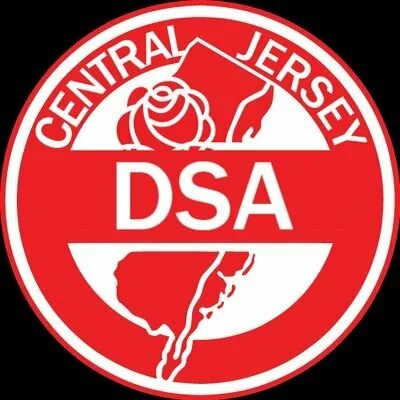

Endorsing & Enforcing Railroad Workers’ Right to Strike
Wheareas,
- The labor movement has long been recognized as the most important engine for socialist change in society due to its power to halt the flow of goods and services the capitalist class depends on.
- Socialists recognize that the right to strike or threat thereof is the primary and most powerful instrument of the labor movement and should never be surrendered under any circumstances.
- Railroad workers have been working under inhumane Dickensian conditions where their employers will not grant them even a single sick day during a pandemic in order to disgustingly benefit themselves by extracting larger profits from their labor.
- A central demand of the rail worker’s unions has been to be granted a reasonable period of sick leave.
- Rail workers died at more than twice the rate of other workers from Jan. 2020 to May 2022 and more than three times other workers in 2021 according to the Centers for Disease Control and Prevention’s MMWR.
- The United States shifted to a service economy model, which reduced reliance on domestic production for the stuff of everyday life. This reduced the power of domestic factory workers, but wildly enhanced the potential power of logistics workers in airline, shipping, trucking, and rail industries that are situated between a global production system and a domestic consumption system.
- Threatened by this potential halt to critical infrastructure, the capitalist government is attempting to declare the strike illegal via the passage of legislation. This in effect would make railroad workers involuntary labor, banned under the 13th amendment (except for its racist loophole for people convicted of a crime). Presumably, such a law will be eventually backed with force of arms if workers disobey.
- DSA National put out a statement calling for a NO vote on H.J. 100 at 10:41am, about two hours before roll call at 1:02pm. While not ideal, this is sufficient time for DSA federal representatives to be made aware of it.
- Three DSA elected officials, Reps. Alexandra Ocasio-Cortes (AOC), Jamaal Bowman, and Cori Bush voted for a bill that would make the railroad strike illegal. We applaud the fact that Rep. Rashida Tlaib did vote no.
- AOC tweeted that the union asked her to vote this way to protect a sick days amendment that would obviously die in the Senate (and did).
- The DSA has long had issues with our federal elected officials deviating from our political platform.
- We must call our representatives to explain themselves to the DSA National Political Committee. While we are encouraged by DSA National releasing a statement that denounces the vote to break the strike and which calls for a town hall to discuss this, this statement does not meet all of our demands, which include a meeting with the wayward electeds to demand an explanation.
- It is critical that DSA state in the clearest terms that we did not endorse H.J. 100 and do endorse workers’ right to strike. To do otherwise will perhaps irreparably damage our ability to support striking workers. Why would they trust an organization whose representatives actively attacked them from the heights of federal power?
Therefore be it resolved,
- Central Jersey DSA endorses the “Railroad Workers United Open Letter to Congress and the President”.
- Central Jersey DSA endorses the letter authored by Seattle DSA Local Council “3 DSA Members in Congress Vote to Ban Railroad Strike — They Don’t Speak For Us”.
- If a railroad strike actually develops, Central Jersey DSA will do its part to support the strike.
- Central Jersey DSA will publish this resolution on social media to educate our constituency and the broader public on our position.
The post Endorsing & Enforcing Railroad Workers’ Right to Strike appeared first on Central NJ DSA.


Statement on the Red Oak Community School Drag Story Hour
Fascist violence against LGBTQ+ people in America is a terrible and growing force. Last month, five people – Daniel Aston, Raymond Green Vance, Kelly Loving, Ashley Paugh, and Derrick Rump – were murdered and nineteen others were wounded at Club Q in Colorado Springs. We will remember their names as well as the right-wing cultural narrative that made their suffering possible. Right-wing politicians, media figures, and pretend intellectuals have furthered violence against the LGBTQ+ community by spreading fear and misinformation. The entire right shares the burden of responsibility for the massacre in Colorado.
Here in Ohio, we have become intimately acquainted with the right-wing political movement. It has gained critical ground in our state and scored brutal victories against our people. From shameless police violence in Akron and Columbus to assaults on reproductive rights statewide, artifacts of the right’s surging hatred can be seen everywhere. It will next rear its ugly head here in Columbus on Saturday, December 3, when the Proud Boys – a fascist, white-supremacist paramilitary organization – will menace children and harass families at a drag queen story hour hosted by Red Oak Community School at the First Unitarian Universalist Church. This action is no doubt aligned with the fascist strategy to demonize LGBTQ+ people, incite political violence, and prevent those they deem lesser from ever feeling safe – even in places of worship. We join other groups in our city in condemning the Columbus Proud Boys, their violent rhetoric, and their intrusion into our communities. We call on our members and allies to challenge homophobic ideology wherever it manifests in central Ohio.
No one should ever feel threatened because of their sexuality or gender identity. As human beings, we all deserve safety, freedom, and joy. There is no room for joy in a culture that denies the existence of LGBTQ+ people or that subjects them to mass death for having dared to be who they are. We are finished ceding ground in Ohio to the far right. To counter the spread of fascism, we must build a unified left here in Columbus and abroad.
Columbus DSA is proud to be a part of that struggle, now and forever.
DSA is a socialist feminist and anti-fascist project for collective liberation. Our members are coordinating among themselves and within the community to protect Columbus from extremist violence. For information on how to support the event, including opportunities to fundraise for LGBTQ+ causes and volunteer on the day of, visit the Red Oak Community School website.
Additional Reading:
Abolition of White Supremacy
Gender and Sexuality Justice
Justice for Trans People Requires Power


PUBLIC STATEMENT BY BOSTON DEMOCRATIC SOCIALISTS OF AMERICA IN SUPPORT OF RAIL UNION WORKERS
The rail freight carriers that employ approximately 125,000 unionized employees have spent years prioritizing shareholders and executives, making record profits for the railroad industry. At the same time, the carriers have downsized the rail workforce by furloughing approximately 30% of rail workers, increasing the workload for those who remain. Workers do not receive paid sick time and are expected to be available to work any time of day or night at short notice. On top of this, workers have received a 0% pay increase over the last three years.
The Biden administration brokered a tentative agreement that excluded a substantial amount of the unions’ demands. In a vote of the rail union membership, over half the rail workforce and four of the 12 unions representing those employees voted down this proposal. If there is a strike by the rail workers, any damaging effect on the economy will have been caused by the greed and intransigence of the rail companies, and the failure of Congress and the Biden administration to broker a decent agreement that addresses the workers’ demands.
Boston DSA fully and adamantly supports the democratic right of the rail union workers to vote down any proposed agreement, including the tentative agreement brokered by the Biden administration. Boston DSA opposes any legislation that would impose terms and conditions of employment on the rail unions and thereby take away the workers’ right to strike. The National DSA has also recognized the rail workers right to strike and has put out a statement in support of the rail workers, and Boston DSA concurs with the statement issued by the National DSA.
Most importantly, if and when Congress and President Biden enact legislation taking away the right to strike by the railway workers, Boston DSA will support the actions of the rail workers, including any decision to strike. Boston DSA will be there to support the workers, including joining them on the picket lines. Solidarity now, solidarity forever.
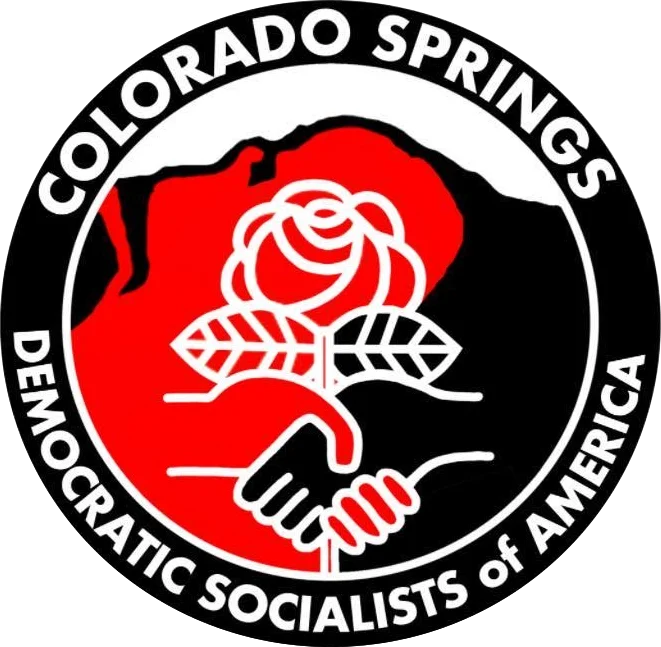

Colorado Springs DSA Statement on the Tragedy at Club Q

It is hard to find the words to express the depth of the trauma and grief that our chapter and community are experiencing in the wake of the mass shooting at Club Q. That we are issuing this statement a few days after the event is a testament to the fact that we have been in deep mourning as we attend multiple community vigils and spend time supporting one another. We all understand how close this act of hatred brought us to losing chapter members who are deeply loved and valued, and our hearts break for our comrades who lost friends and loved ones to this tragedy.
As difficult as it is to move forward, our solidarity with one another and the greater LGBTQ+ community is helping us find the strength to begin the organizing work that must follow. It has not been lost upon us that while CSPD was busy surveilling our chapter last summer and arresting our comrades who were marching for affordable housing in our community, the District Attorney was busy dropping charges against the right-wing terrorist that perpetrated this weekend’s armed attack. It is not lost upon us that this terrorist is the grandson of a fascist MAGA politician in California. It is not lost upon us that Colorado Representatives Lauren Boebert and Doug Lamborn have boosted anti-LGBTQ+ rhetoric while supporting the gun lobby that made this weekend’s tragedy possible. It is not lost upon us that evangelical churches in our city operate as political actors to create a climate of intolerance where bigotry and zealous hatred are incubated. And it is not lost upon us that all these fascist bad faith actors ultimately work together to silence and oppress our community, especially those amongst us who are the most marginalized.
Colorado Springs DSA and the community we serve will not be silenced. We will not submit to the fear that right-wing politicians and their followers try to instill in us. This moment makes it clearer than ever how urgent it is for us to stand up for our community and fight for our rights, to stand against hatred and violent state oppression, to stand against the cold and calculated sacrifice of our BIPOC and LGBTQ+ siblings by fascist capitalists seeking a scapegoat for the inhumane inequality that their greed creates, and we take that stand now, together.
We’ve got us. We stand strong in solidarity, carrying those who are wounded, and march on.
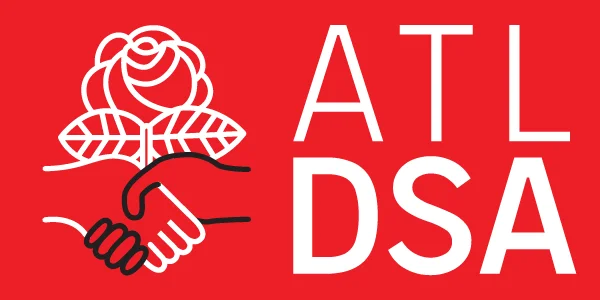

Fight for Abortion Rights, Defeat Herschel Walker
Atlanta DSA Statement on December 6th Senate Runoff Elections
The Senate Runoff Election in Georgia will have important consequences for working-class people across the country. Although Democrats have lost control of the House of Representatives for now, the winner of this runoff will hold a critical Senate seat for 6 years—the entire duration of the next Presidential term. Herschel Walker is a millionaire capitalist and far-right extremist. If elected, he could be the deciding vote that blocks moves to abolish the filibuster and pass other critical legislation. For these reasons we encourage our members, supporters, and the public to vote to defeat Herschel Walker and his far-right agenda.
The 2024 elections will present a huge opportunity for the growing socialist movement to shift the balance of power in the United States. The Left could lead the charge to abolish the filibuster and clear the path for historic gains for the working class by legalizing abortion nationwide and passing the PRO Act. Expanding voting rights could permanently alter the political battlefield and make it impossible for the minoritarian neo-fascists in the GOP to capture the federal government again. Herschel Walker’s election to the US Senate could rule out all of these possibilities for six years.
Make no mistake: working-class people have fundamentally different interests from the neoliberal elites in the Democratic Party establishment. DSA remains committed to advancing our democratic socialist perspective by building a democratic working-class organization. In this election, we are building independent working-class power by making sure that young workers and people of color know how to vote. We are getting out the vote by helping the public navigate barriers to voting, and promoting political issues like abortion rights from a socialist perspective. We encourage everyone to make a plan to vote as early as possible, to join us in continuing to fight for abortion rights no matter who wins the runoff, and to join DSA to help build an economy and society that works for the many, not the few.
Find your polling place and make a plan to vote early at atldsa.org/vote
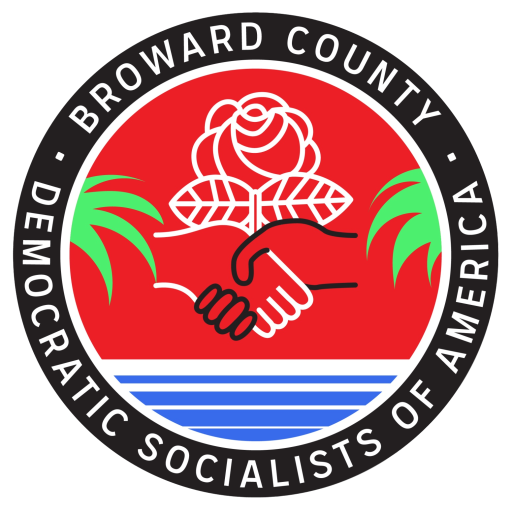



Hello world!
Welcome to WordPress. This is your first post. Edit or delete it, then start writing!


Jackson Water Statement
For decades, America’s water infrastructure has rusted under the negligent eye of politicians who have put politics and dollar signs above their constituents. The water crisis in Jackson, Mississippi reminds us of how racism and capitalist greed can threaten the supply of even the most basic human necessity.
Central New Jersey Democratic Socialists of America calls upon the Biden administration, the state of Mississippi, and state and local governments both in NJ and nationwide to put their money where their mouth is by funding safe and robust water infrastructure as a public utility. Access to water, necessary to sustain human life, should not depend on the profit margins available to private companies for delivering it, nor on emergency funding that is only available once a crisis point is reached. Given the vast wealth of our nation we can easily provide safe and reliable water to everyone as a public utility. This should not be in question, either in Mississippi nor in New Jersey.
The crisis of Jackson Mississippi’s water system is not merely a crisis of underfunding but is also a direct result of the profound ecological crisis wrought on humanity by climate change. Although decades of underfunding from both the federal government and the state government of Mississippi precipitated the failure of the Jackson Water System, notably the need for an additional $4.8 billion to maintain safe drinking water, two events in particular caused the system to fail as catastrophically as it did this september. While the media was largely focused on the failure of the Texas power grid that resulted from the February 2021 cold snap, the lower than usual temperatures also froze the pipes that supplied the water to Jackson Mississippi and damaged them irreparably. The situation was made worse this summer as the system endured damage from the massive floods that swept through Mississippi this summer.
At this point in the climate crisis there can be no debate between adapting to climate change or preventing it; we need to do both. An eco-socialist transition away from carbon intensive production and extraction needs to occur simultaneously with a reworking of our infrastructure to withstand the stress that will be put on it as a result of climate catastrophe or else we will see more cities struggle with the issues that Jackson Mississippi is currently facing.
In addition, the recent water main break in the Belleville area shows alarming parallels to what has happened in Jackson. In August of 2022, more than 100,000 households were affected with reduced water access after a 142-year-old water main ruptured. Like in Jackson, neglected infrastructure was the immediate cause. Contrary to what many would like to believe, New Jersey isn’t immune to images of bottled water packages and closed schools. New Jersey as of this year still has 186,830 discovered lead lines, and potentially up to 350000 from some estimates. Even outside of more momentous events like ruptures, many are forced to choose between risking unsafe water or paying for bottled water. Organizations like Newark Water Coalition still organize to bring to light continued concerns of poor infrastructure and insufficient fixes, especially in Newark where two years ago there was still estimated 24% lead piping.
Further, water privatization is rampant in New Jersey, increasing the cost of water as well as the risk of disasters like what happened in Jackson. For-profit water companies make no sense in a rational world- When a water system is given over to a for-profit company, as is currently planned to happen next year in Somerville here in Central Jersey, that company can make money (its sole objective) from that water system compared to a cost-neutral government-run system in one of two ways: Increasing the price of water for residents, or decreasing the amount spent maintaining the system (risking a Jackson-like disaster). Yet sadly some see it as the only way to fund necessary expansions to supply new houses and rising populations due to the lack of funding available to local governments for water projects.
The defunding of municipal water projects has not only occurred on the state level but was precipitated by cuts in funding on the federal level that occurred during the Reagan Administration as a result of the 1987 Water Quality Act. Republican lead efforts to “shrink government” and “lower the deficit” are not merely philosophical statements on the role of the state in private life or simple adjustments to the accounting on the federal ledger. The “Reagan Revolution” and the ideological justifications for austerity that came with it have had an immensely negative impact on the lives of the most vulnerable members of the working class who often have to shoulder the cost of republican tax cuts for the rich and the decimation of public services that result from them.
We must work within our communities and then expand outwards to recognize how much more needs to be done to repair the situation we are dealing with. Addressing poor piping in general, lead piping especially, fighting back against privatization and the usage of these crises to further increase exploitation are all incredibly necessary. As with many concerns, the solution is to build the power and organization of the working class, so we can address our social interests and concerns in ways capitalists will not. Groups like Newark Water Coalition, Food and Water Watch, and ecosocialist caucuses within DSA are working to build a movement for a more sustainable and environmentally sound world and organizing for water justice is an essential part of making the urban areas where most working class people live safer and healthier.
The post Jackson Water Statement appeared first on Central NJ DSA.